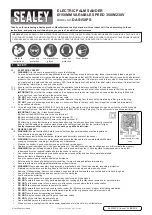
4.3. SWITCHING ON AND OFF
4.3.1. Connect the Power Cord to the mains power supply.
4.3.2.
Push the On/Off Switch in to the ‘I’ position, to switch the sander ‘on’.
4.3.3.
To switch ‘off’ the sander, push the On/Off switch in to the ‘O’ position.
4.3.4. Adjust the rpm speed by using the
rpm+
&
rpm
-
buttons (fig.1). Speeds range from 4,000rpm to 10,000rpm, each press increases
+
or decreases
-
by 1,000rpm.
4.3.5.
Once the desired speed is set, push down the lever (fig.1) and the tool will start slowly, then quickly get up to speed, ready to use.
WARNING:
Always wait until the machine has stopped vibrating completely before putting it down. Always disconnect from the
power supply after use.
4.4.
SANDING
4.4.1.
If the tool is connected to a vacuum dust extraction system, switch the extraction device ‘on’ before switching on the sander. Switch
the sander ‘off’ first, then the vacuum system.
4.4.2. Move the machine in a circular motion over the workpiece surface, applying an even, moderate pressure until you reach the desired
surface finish.
WARNING:
Excessive pressure does not lead to a faster removal of material; it will, however, lead to premature wear of the sanding
disc, and may cause damage to the machine.
4.4.3.
If there are still scratches on your workpiece after sanding, refer to ‘Selecting
the right grade of sanding disc’.
5. MAINTENANCE
WARNING:
Always disconnect from the power supply before carrying out any inspection, maintenance or cleaning.
5.1.
GENERAL INSPECTION
5.1.1.
Regularly check that all the fixing screws are tight.
5.1.2. Inspect the supply cord of the tool, prior to each use, for damage or wear.
5.1.3. Repairs should be carried out by an authorised service centre.
5.2. CLEANING
WARNING:
Always wear protective equipment including eye protection and gloves when cleaning this tool.
5.2.1. Keep your tool clean at all times. Dirt and dust will cause internal parts to wear quickly, and shorten the device’s service life.
5.2.2. Clean the body of your machine with a soft brush, or dry cloth.
5.2.3.
Never use caustic agents to clean plastic parts. If dry cleaning is not sufficient, a mild detergent on a damp cloth is recommended.
5.2.4.
Water must never come into contact with the tool. Ensure the tool is thoroughly dry before using it.
5.2.5. If available, use clean, dry, compressed air to blow through the ventilation holes (where applicable).
5.3. LUBRICATION
5.3.1. Slightly lubricate all moving parts at regular intervals with a suitable spray lubricant.
5.4.
STORAGE
5.4.1. Store this tool carefully in a secure, dry place out of the reach of children.
6. TROUBLESHOOTING
Problem
Possible cause
Solution
N
o function when On/
Off Switch is operated
No power
D
efective On/Off Switch
Check power supply
H
ave the On/Off Switch replaced by an authorised service centre
Slow material removal
S
anding sheet too fine or worn
Fit new sanding sheet with coarser grit
Scratches on workpiece
after sanding
Sanding sheet too coarse
Not enough material removed
F
it new sanding sheet with finer grit
Continue sanding
B
urn marks on
workpiece
Sanding sheet incompatible with material
Too much pressure exerted on to the sander
Fit correct sanding sheet
U
se less pressure whilst moving the machine
Excessive dust
emission
Dust extraction not working;
Sanding sheet not aligned with dust extraction
holes in the hook & loop sanding base
Extraction holes blocked
Have dust extraction unit seen by an authorised service centre
Realign sanding sheet
U
nblock dust extraction holes
D
AS150PS | Issue 1 22/08/2019
Original Language Version
© Jack Sealey Limited




